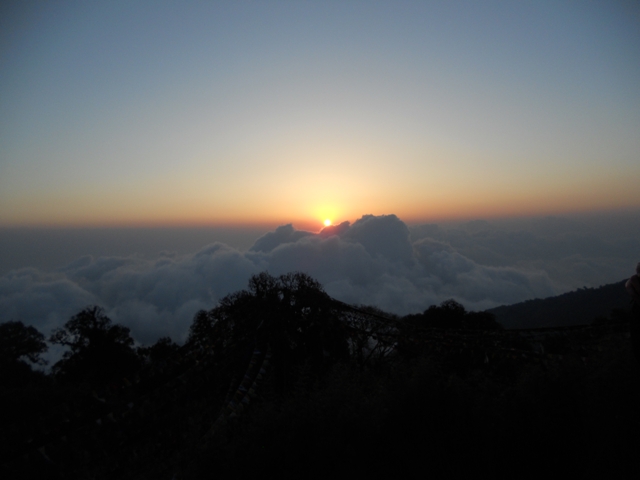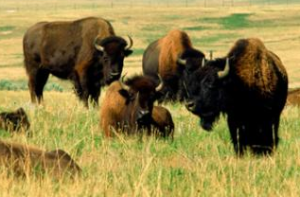This destination travel piece was originally featured on the bi-weekly Sunday travel page of Milwaukee’s Third Coast Daily. It was reposted by Darjeeling Times.com.
Sunrise
It worked. The faint beep of my watch alarm—along with a dose of eager anticipation—was enough to wake me. It’s 3:45 a.m. I bundle up, grab my camera and step out to the street in front of the guesthouse to look at the black sky above Darjeeling.
“If you see stars,” my host had advised, “that means a clear sunrise.” I do see stars, so I continue down through the Chowrasta—the plaza centerpiece of town—to the jeep stand, pack into a jeep along with a dozen other bodies, and 20 minutes later arrive at the observatory at the top of Tiger Hill.
In the cold predawn air, momentarily disappointed that my ticket won’t allow me into the elevated indoor viewing room, I flow with the masses to the far end of the outdoor observation deck. There I stand, hold the rail, and look out over a sea of clouds dotted with only a few small hilltop islands, and one massively glaring exception: Khangchendzonga—Earth’s third highest peak—jutting high above the clouds, fiercely ragged and cold yet bright pink in its early glimpse of the sun.
I see snow swirling above the peak. A chill shoots through my body as this visual adds to the already cold air around me. Sure, it’s April in India, but it’s also a 10,000 ft. elevation at 4:40 in the morning. I’m glad to be wearing every layer I packed for my months of travel in the Indian subcontinent.
Tourists chatter, local women with thermoses bark “coffee, coffee”—surprising in India’s premier tea region—and we wait for the headliner (the star, if you will) of the show. I gaze back at the indoor observatory and note that what’s gained in warmth is made up for by being packed into a room and witnessing the arrival of daylight through pane glass. The “cheap seats” are the way to go at Tiger Hill, it seems. I couldn’t be happier.
Applause startles me out of my class-war daydream. I turn around to see the grand entrance—stage left—reaching bright rays across the clouds. The sun has risen. Mighty Khang is unfazed, but the world around me blossoms as light spills into all open spaces. Usually one to avoid tourist crowds, I delight in this moment: hundreds of people from all over the world, giving a standing ovation to the rising sun.
Moments later I’m collected by the driver, packed into the jeep, and driven back to town. But first we stop at a monastery in Ghoom, where brilliant, bright floor-to-ceiling frescoes surround a 10-foot golden, seated Buddha. Apparently Tiger Hill was only part of the tour my $2.50 bought me. Like it or not, we’re going to take in more sights. I don’t know how many—nor do I share a language with anyone else in the jeep—but I do like it. This is all bonus time for me, after all. I’ve been up for hours and it’s still only 6 a.m. I’m enjoying surrendering to the process. Each day in these hills I feel another layer of urgency fall from my habits.
At a second stop, I buy a cup of sweet, hot, milk tea and stroll as the rising sun fights the crisp cold of morning. Sunlight blasts through the crags and nooks of the Darjeeling hills stretching out around me. An ad hoc marketplace is set up in the circle of train tracks that run up the hill behind me, capturing this daily early morning rush of tourist traffic. I take a seat on the rails, content to sit, sip, watch and wait.
The circle is the Batasia Loop of Darjeeling’s Toy Train, winding around a large black obelisk war memorial set against blue sky and the distant white peak of Khangchendzonga.
“Toy Train” is the common name for Darjeeling’s famous mountain train, but the official name, Darjeeling Himalayan Railway, better speaks of its majesty. This 130-year old wonder of narrow gauge engineering runs 55 miles from the plains up to the city of Darjeeling, climbing 7,000 feet in just 40 of those miles. To achieve this, the rail line has six Z-reversals—essentially switchbacks—where the engine detaches, swings around back and pulls the train in the opposite direction up the next steep incline. It also has three loops where the train performs a 360 degree circle in order to gain a dozen feet. The Batasia Loop is the train’s most famous turnaround.
I haven’t ridden the train yet, traveling by jeep each of my trips up and down parts of Hill Cart Road. Most of my 10 days in the region have been spent in Makaibari tea village about 20 slow miles down the road, and that’s where I’ll return after my time in Darjeeling city.
Nayan, my host in the village, tells me the train is a must, “like the Taj Mahal and the Paris Tower,” he says. I will take it back to Makaibari on Saturday.
India is challenging, and simply getting from place to place provides a dose of adventure not recommended for the timid. But getting to Darjeeling is a worthwhile effort. The unhurried pace of life is pleasantly contagious, the marketplaces and tourist opportunities are free of the pushiness found in lower elevations, and there’s plenty to see and do—from the beautiful zoo to the inspiring Himalayan Mountaineering Museum, to the multiple trekking options. But, for the most part, I’m content just taking in the sweetness and relative quiet of the town itself, and learning to submit to rhythms larger than my own task list.
The Chowrasta
In my two visits to the town of Darjeeling, I’ve stayed in two very different guesthouses. On my first nights in the region just under two weeks ago, I stayed at the Classic Guesthouse. At $40 a night this now seems purely luxurious.
Though it was perfect at the time—large room, private bath and top-of-the-world private deck—on this second visit I’ve downgraded to the Rewang Guesthouse, a budget hovel up the road from the Chowrasta, where less than $12 gets me a no-frills room plus two meals each day.
Both Guesthouses are within walking distance of anything I want to do—especially since most of what I want to do is walk along the roads that traverse the dramatic landscape. And when not walking, I find most of my needs met right in the Chowrasta. At Sonam’s Kitchen for wonderful breakfasts of Darjeeling tea, thick brown bread toast, slices of aged yak cheese, salty grilled tomatoes, perfectly prepared eggs-over-easy and hash browns, all infused with Sonam’s kind smile. At the English-language Oxford Bookstore, where I get lost perusing volumes of fiction and Buddhist texts. And at Nathmull’s Tasting Room where several varieties of delectable cakes are served up alongside dozens of top quality regional teas.
But even the best tearooms in town give a taste of Darjeeling tea that could be replicated elsewhere. For a deeper tea experience it’s necessary to visit the plantations themselves, to walk among the precarious rows of tea bushes in the nearly vertical fields, to witness the processing of tea leaves in one of the factories, and to expertly slurp perfect, fragrant brews in an estate’s tasting room.
Tea Time
In the mid 1800?s, the British Empire and the East India Company determined that growing tea in the colonized lands would effectively compete with Chinese production, providing lower priced goods back home in Britain. The lush, high elevation forests of Darjeeling proved a worthy experiment for the production of a tea more delicate in flavor than the lower elevation Assam varieties. Darjeeling is now considered the finest black tea in the world.
Few factories are as accommodating as Makaibari Tea Estate, my temporary village home. Built in 1859, Makaibari was the first factory in the hills. Just over a century later the estate continued its pioneering ways, becoming the first organic producer in the region. Today it is a model organic and fair trade tea estate.
Spending several days in Makaibari’s home stay program is the ideal way to experience village life and the multiple stages of tea production. There, my room awaits in the small, rustic, three generation Bhujel family home a short walk from winding paths through beautiful tea fields or through the factory gates to see the processes of tea production, virtually unchanged in 150 years: tea leaves withering on hundred-foot long ventilated tables, curling in the large rolling machines, drying in the locomotive-like oven, and being sorted by the colorful sari-wrapped ladies in the sorting room.
Saturday
In fact, it’s time to leave the city and return to Makaibari village. Keeping my promise to myself and to Nayan, I’ve booked myself on the 10 a.m. Toy Train.
At the station I find my seat in the small enclosed car, and begin the slow pull up to Ghoom—and the Batasia loop—and then down the series of ridges toward my destination.
Following the main road, the train doesn’t offer unique views, and at half the speed of the jeeps I wonder if it would’ve been better to just look at the train and then jump into another jeep. The worldly marvel of this train, it seems, is more intellectual than experiential.
In contrast to the aggressive lunging and swerving jeeps, however, the train does offer time and space to appreciate the surroundings. I walk to the end of the small car, hang out the open door and take in a view of hills that plunge into misty valleys a thousand feet below. I return to my seat. I even sleep.
I arrive at my stop: the town of Kurseong, and walk the 30 minutes down the steep road to Makaibari. Nayan spots me as I stroll into the village. “Did like you like the train?” he asks eagerly.
Recalling his excited recommendation, I smile. It certainly wasn’t a Taj Mahal or Eiffel tower, and I probably shouldn’t tell him I fell asleep. But the slow chug of the train was indeed fast enough. A sense of hurry will eventually reclaim me. For now I’ve been delightfully infected by the sweet pace of the Darjeeling hills.
“Yes,” I answer truthfully. “I loved it.”




